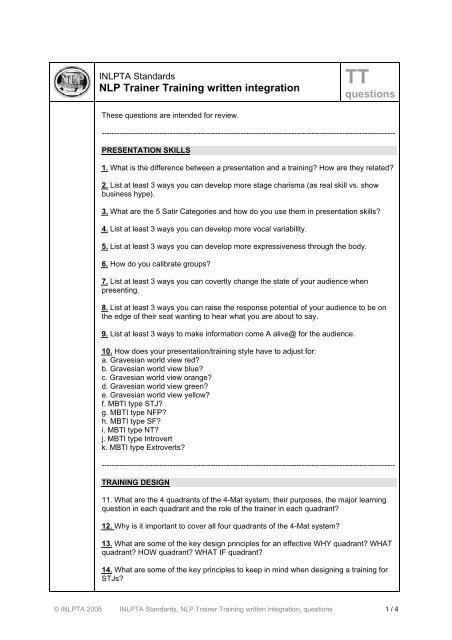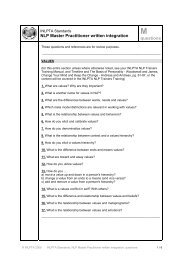NLP Trainer Training written integration questions - INLPTA
NLP Trainer Training written integration questions - INLPTA
NLP Trainer Training written integration questions - INLPTA
You also want an ePaper? Increase the reach of your titles
YUMPU automatically turns print PDFs into web optimized ePapers that Google loves.
I<strong>NLP</strong>TA Standards<strong>NLP</strong> <strong>Trainer</strong> <strong>Training</strong> <strong>written</strong> <strong>integration</strong>TT<strong>questions</strong>These <strong>questions</strong> are intended for review.--------------------------------------------------------------------------------------------------------------------PRESENTATION SKILLS1. What is the difference between a presentation and a training? How are they related?2. List at least 3 ways you can develop more stage charisma (as real skill vs. showbusiness hype).3. What are the 5 Satir Categories and how do you use them in presentation skills?4. List at least 3 ways you can develop more vocal variability.5. List at least 3 ways you can develop more expressiveness through the body.6. How do you calibrate groups?7. List at least 3 ways you can covertly change the state of your audience whenpresenting.8. List at least 3 ways you can raise the response potential of your audience to be onthe edge of their seat wanting to hear what you are about to say.9. List at least 3 ways to make information come A alive@ for the audience.10. How does your presentation/training style have to adjust for:a. Gravesian world view red?b. Gravesian world view blue?c. Gravesian world view orange?d. Gravesian world view green?e. Gravesian world view yellow?f. MBTI type STJ?g. MBTI type NFP?h. MBTI type SF?i. MBTI type NT?j. MBTI type Introvertk. MBTI type Extroverts?--------------------------------------------------------------------------------------------------------------------TRAINING DESIGN11. What are the 4 quadrants of the 4-Mat system, their purposes, the major learningquestion in each quadrant and the role of the trainer in each quadrant?12. Why is it important to cover all four quadrants of the 4-Mat system?13. What are some of the key design principles for an effective WHY quadrant? WHATquadrant? HOW quadrant? WHAT IF quadrant?14. What are some of the key principles to keep in mind when designing a training forSTJs?© I<strong>NLP</strong>TA 2005 I<strong>NLP</strong>TA Standards, <strong>NLP</strong> <strong>Trainer</strong> <strong>Training</strong> <strong>written</strong> <strong>integration</strong>, <strong>questions</strong> 1 / 4
15. What are some of the key principles to keep in mind when designing a training forNFPs?16. What are some of the key principles to keep in mind when designing a training for alarge proportion of Introverts?17. What are some of the key principles to keep in mind when designing a training for amixed audience of Myers-Briggs types?18. What are some of the key principles to keep in mind when designing a training forGravesian world view:a. red?b. blue?c. orange?d. green?e. yellow?19. What are some of the key principles to keep in mind when designing a training for amixed audience of Gravesian world views?20. In your opinion, what is an ideal structure (regarding time frames, number ofsessions, length of sessions, etc.) for an <strong>NLP</strong> Practitioner and Master Practitionertraining? If you had to tailor this structure to meet any commercial constraints(customer wants and needs, marketing and production costs, room hire, venueavailability, etc) of your market place, how would you do it while preserving the benefits(Secondary gains) of your ideal structure?21. What information is useful for you to know when designing a training?--------------------------------------------------------------------------------------------------------------------EXERCISES AND DEMONSTRATIONS22. What information is useful for you to know when designing an exercise?23. What are some of the keys to designing an exercise?24. What are some of the keys to facilitating an exercise?25. What are some of the keys to debriefing an exercise?26. What are some of the key principles to keep in mind when designing andconducting a demonstration?27. What are some of the potential side effects with your students learning processesafter having seen a demonstration?28. When is it useful to conduct a demonstration and when not?29. Explain how you would frame, design and debrief an exercise for STJs? (pick anexercise relevant to your area of training interest)30. Explain how you would frame, design and debrief an exercise for NFPs? (pick anexercise relevant to your area of training interest)31. Explain how you would frame, design and debrief an exercise for SFs? (pick anexercise relevant to your area of training interest)32. Explain how you would frame, design and debrief an exercise for NTs? (pick anexercise relevant to your area of training interest)© I<strong>NLP</strong>TA 2005 I<strong>NLP</strong>TA Standards, <strong>NLP</strong> <strong>Trainer</strong> <strong>Training</strong> <strong>written</strong> <strong>integration</strong>, <strong>questions</strong> 2 / 4
33. Explain how you would frame, design and debrief an exercise for Introverts? (pickan exercise relevant to your area of training interest)34. Explain how you would frame, design and debrief an exercise for Extroverts? (pickan exercise relevant to your area of training interest)35. How might you design a Master Practitioner training differently than a Practitionertraining?36. Explain how you would frame, design and debrief an exercise for MasterPractitioners differently than for Practitioners?--------------------------------------------------------------------------------------------------------------------FACILITATION SKILLS37. What are some of the benefits and limitations of Accelerated Learning?38. What are the 7 learning strategies as identified by Generative Learning?39. What is meant by Generative Learning? How is it different but related to Bateson=sdistinction of learning level 3 and his logical levels of learning?40. How do you do the My Friend John pattern as applied to handling <strong>questions</strong> ingroups?41. List at least 5 ways in which a student can hinder their own learning. How mightyou facilitate them in each situation?42. How can logistics and environmental orchestration help to facilitate unconsciousprocesses of learning?43. How would you orchestrate an optimum learning environment in your trainingcontext?44. Explain how nested loops work, and how you can use them to facilitateunconscious learning processes.45. How would you determine that your (and others) use of nested loops is ecological?46. What are the benefits and limitations of using a nested loop design?47. What is the difference between an inductive and deductive method oftraining/learning? What are the benefits and limitations of each approach? When is itappropriate to use which?48. With regards to a student=s learning outcomes, what would be your outcomes if thestudent is at a level of unconscious incompetence? Conscious incompetence?Conscious competence? Unconscious competence?49. Explain how you would facilitate learning differently with Master Practitioners thanPractitioners.--------------------------------------------------------------------------------------------------------------------PROFESSIONALISM, ETHICS AND ASSESSMENT50. When presenting <strong>NLP</strong> content, what are some of the ways in which you willfacilitate your students to maintain ecology frames with <strong>NLP</strong>?© I<strong>NLP</strong>TA 2005 I<strong>NLP</strong>TA Standards, <strong>NLP</strong> <strong>Trainer</strong> <strong>Training</strong> <strong>written</strong> <strong>integration</strong>, <strong>questions</strong> 3 / 4
51. What are some ways in which you can monitor the ecology of how your studentsare learning and applying <strong>NLP</strong>?52. How would you respond if you found out one of your students was using their <strong>NLP</strong>skills unecologically on others? List some of the various ways you might handle thesituation.53. Under what conditions would you NOT certify a Practitioner? Master Practitioner?Explain the conditions and your reasons.54. Explain the difference in your expectations of a Master Practitioner in relation to aPractitioner with regard to their skill levels, integrated abilities, content knowledge inboth quantity and quality, attitudes, and awareness of self.55. What would be your evidence procedures for knowing that a Practitioner and aMaster Practitioner have reached accreditation status or not?56. When is it more ecological to elicit rather than install strategies? When is it moreappropriate to install rather than elicit strategies? How do you make sure anyinstallations are ecological (especially when working with groups)?57. What are some ways in which you might handle a situation where a Practitioner orMaster Practitioner that you have already certified has been discovered to be usingtheir skills in grossly unethical and unecological ways?58. What are your own personal beliefs and standards regarding how you, as anI<strong>NLP</strong>TA <strong>NLP</strong> <strong>Trainer</strong>, will be conducting yourself with regard to Professionalism,Quality and Ethics?59. What are your own personal beliefs and values regarding how you, as an I<strong>NLP</strong>TA<strong>NLP</strong> <strong>Trainer</strong>, can be optimally conducting yourself in regard to how you relate to yourprofessional peers and colleagues (i.e. other I<strong>NLP</strong>TA <strong>NLP</strong> <strong>Trainer</strong>s)?60. How will you, as an I<strong>NLP</strong>TA <strong>NLP</strong> <strong>Trainer</strong>, facilitate yourself to gain even morelearning and insights from your experience here at the I<strong>NLP</strong>TA <strong>Trainer</strong>s <strong>Training</strong> thatcan help you to further your self evolution?I<strong>NLP</strong>TA USA / AmericaWyatt Woodsmall1201 Delta Glen CourtVienna, VA 22182-1320phone (703) 757-7945fax (703) 757-7946www.inlpta.comwyattwoodsmall@compuserve.comI<strong>NLP</strong>TA EuropeBert FeustelHerzogstr. 8380796 Münchenphone ++49 / [0] 89 / 30779962fax: ++49 / [0] 941 / 5992 30813www.inlpta.orgbert.feustel@inlpta.org© I<strong>NLP</strong>TA 2005 I<strong>NLP</strong>TA Standards, <strong>NLP</strong> <strong>Trainer</strong> <strong>Training</strong> <strong>written</strong> <strong>integration</strong>, <strong>questions</strong> 4 / 4



